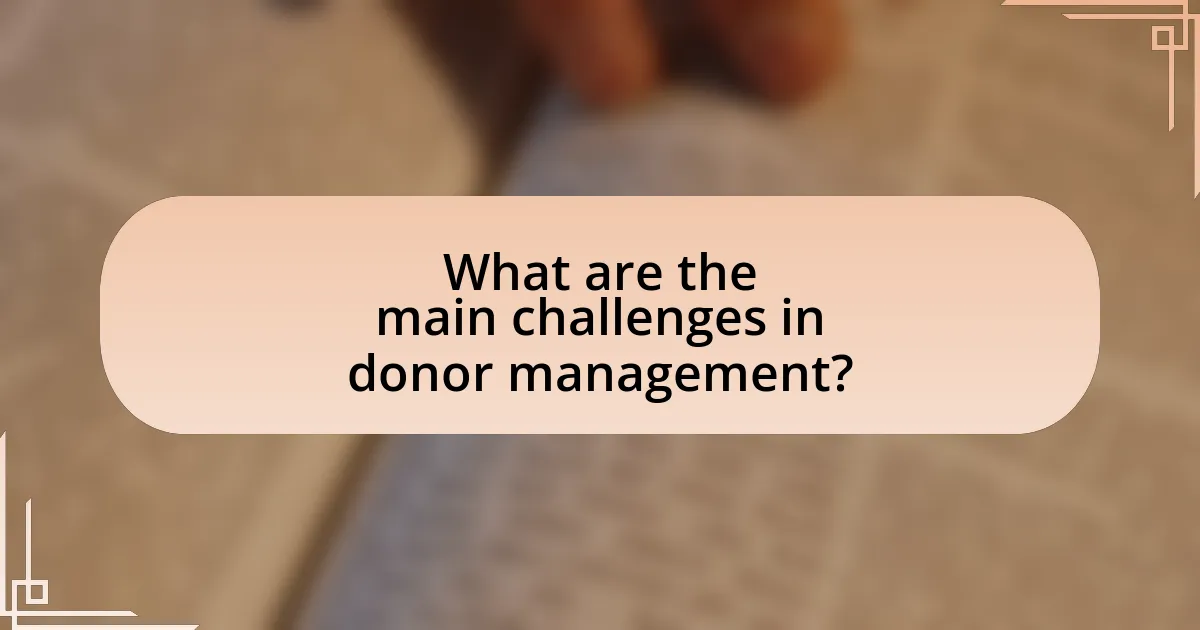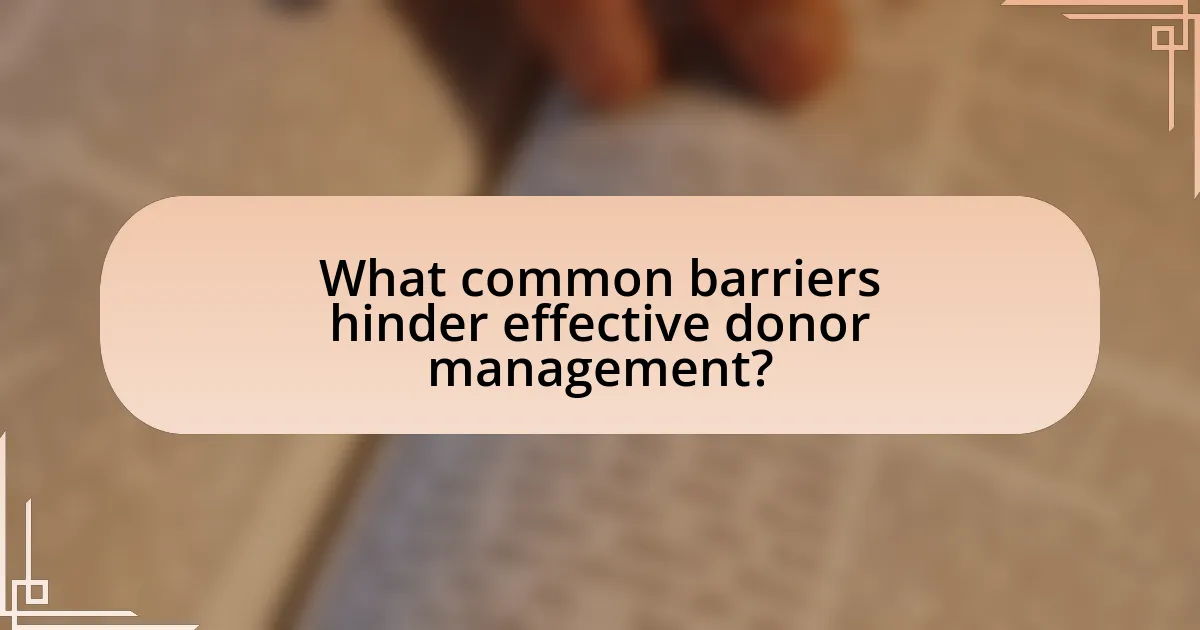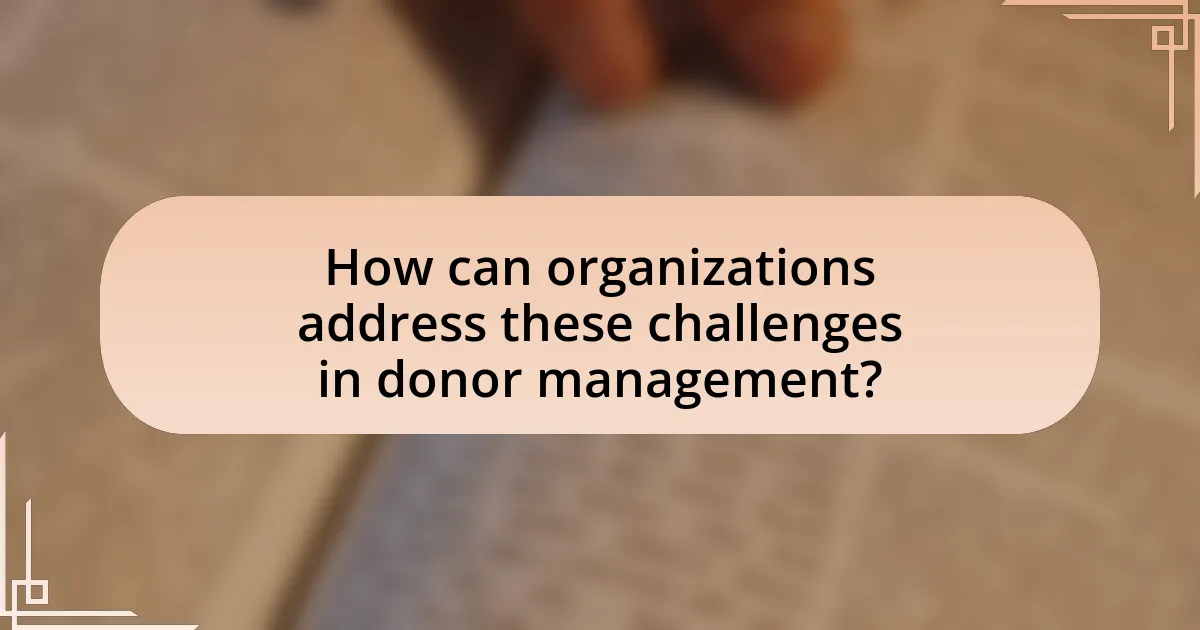The article focuses on the challenges in donor management, highlighting key issues such as maintaining donor engagement, ensuring data accuracy, and managing donor expectations. It explores how these challenges impact the donation process, including barriers that potential donors face, such as lack of trust and unclear communication about the use of contributions. Additionally, the article examines the role of organizational factors in donor management, the importance of understanding donor motivations, and strategies to enhance engagement and retention. It also addresses common barriers to effective donor management and offers practical tips for organizations to improve their donor relationships and fundraising outcomes.
What are the main challenges in donor management?

The main challenges in donor management include maintaining donor engagement, ensuring data accuracy, and managing donor expectations. Donor engagement is critical as organizations often struggle to keep donors informed and involved, which can lead to decreased contributions. Data accuracy is essential for effective communication and relationship building; however, many organizations face difficulties in maintaining up-to-date and correct donor information. Additionally, managing donor expectations is challenging, as donors may have specific desires regarding how their contributions are used, which can create tension if those expectations are not met. These challenges can hinder fundraising efforts and impact overall donor retention rates.
How do these challenges impact the donation process?
Challenges in donor management significantly hinder the donation process by creating barriers that reduce donor engagement and contributions. For instance, issues such as lack of transparency, poor communication, and complicated donation procedures can lead to donor frustration and decreased trust in organizations. According to a study by the Nonprofit Research Collaborative, 30% of donors cited unclear information about how their contributions would be used as a reason for not donating. This indicates that when organizations fail to address these challenges, they risk losing potential donations and long-term supporter relationships.
What specific barriers do donors face when considering a donation?
Donors face several specific barriers when considering a donation, including lack of trust in the organization, unclear impact of their contribution, and competing financial priorities. Research indicates that 63% of potential donors hesitate due to concerns about how their funds will be used, highlighting the importance of transparency in financial reporting. Additionally, emotional factors play a significant role; donors often require a personal connection to the cause, which can limit their willingness to contribute. A study by the Nonprofit Research Collaborative found that 45% of donors cited competing financial obligations as a significant barrier, further complicating their decision-making process.
How do organizational factors contribute to donor management challenges?
Organizational factors significantly contribute to donor management challenges by influencing the effectiveness of communication, resource allocation, and strategic planning. For instance, a lack of clear communication channels within an organization can lead to misunderstandings about donor expectations and engagement strategies, resulting in decreased donor satisfaction and retention. Additionally, inadequate resource allocation, such as insufficient staff training or technology investments, can hinder the ability to track donor interactions and preferences, making it difficult to personalize outreach efforts. Research indicates that organizations with well-defined donor management processes and dedicated resources experience higher donor retention rates, highlighting the importance of organizational structure in overcoming these challenges.
Why is understanding donor motivations crucial?
Understanding donor motivations is crucial because it directly influences the effectiveness of fundraising strategies and donor retention efforts. When organizations comprehend what drives donors to give, they can tailor their messaging and engagement approaches to align with those motivations, leading to increased donations and long-term relationships. Research indicates that 70% of donors are more likely to give again if they feel a personal connection to the cause, highlighting the importance of understanding individual motivations in fostering loyalty and ongoing support.
What psychological factors influence donor decisions?
Psychological factors that influence donor decisions include empathy, social norms, perceived efficacy, and personal identity. Empathy drives individuals to contribute when they feel a connection to the cause or the beneficiaries, as evidenced by studies showing that emotional appeals can significantly increase donation rates. Social norms, such as the behavior of peers or community expectations, also play a crucial role; research indicates that people are more likely to donate if they believe others are doing so. Perceived efficacy, or the belief that their contribution will make a tangible difference, motivates donors; studies have shown that clear communication of impact can enhance this perception. Lastly, personal identity, where individuals align their donations with their values and self-concept, influences their willingness to give, as demonstrated by research linking identity-driven motivations to increased charitable behavior.
How can organizations align their goals with donor motivations?
Organizations can align their goals with donor motivations by conducting thorough research to understand donor interests and values. This alignment can be achieved through surveys, focus groups, and data analysis that reveal what drives donor engagement and commitment. For instance, a study by the Association of Fundraising Professionals found that 70% of donors are motivated by the impact of their contributions, indicating that organizations should clearly communicate how their goals translate into tangible outcomes. By tailoring their messaging and initiatives to reflect these motivations, organizations can foster stronger relationships with donors, ultimately enhancing fundraising success.
What common barriers hinder effective donor management?

Common barriers that hinder effective donor management include lack of communication, inadequate data management, and insufficient donor engagement strategies. Lack of communication can lead to misunderstandings and missed opportunities for relationship building, as studies show that organizations with strong communication practices retain 50% more donors. Inadequate data management results in lost information and inefficient tracking of donor interactions, which can decrease donor satisfaction and loyalty. Insufficient donor engagement strategies fail to create meaningful connections, as research indicates that personalized engagement increases donor retention rates by up to 30%.
How does lack of communication affect donor relationships?
Lack of communication negatively impacts donor relationships by creating feelings of neglect and disconnection. When organizations fail to maintain regular and transparent communication with donors, it can lead to decreased trust and engagement, ultimately resulting in reduced financial support. Research indicates that 70% of donors feel more connected to organizations that communicate effectively, highlighting the importance of consistent updates and acknowledgment of contributions. Without this communication, donors may feel undervalued, leading to a decline in their willingness to continue supporting the organization.
What are the consequences of poor communication strategies?
Poor communication strategies lead to misunderstandings, decreased donor engagement, and ultimately reduced donations. When organizations fail to convey their mission, goals, and needs effectively, potential donors may feel disconnected or uninformed, resulting in a lack of trust and support. Research indicates that organizations with clear communication strategies experience 50% higher donor retention rates compared to those with ineffective communication (Source: “The Importance of Communication in Nonprofit Organizations,” by the Nonprofit Research Collaborative). This highlights the critical role that effective communication plays in fostering relationships and securing ongoing financial support.
How can organizations improve their communication with donors?
Organizations can improve their communication with donors by implementing personalized communication strategies that cater to individual donor preferences and engagement history. Research indicates that personalized communication increases donor retention rates by up to 50%, as it fosters a sense of connection and appreciation. Utilizing data analytics to segment donors based on their giving patterns and preferences allows organizations to tailor messages, ensuring that communications are relevant and timely. Additionally, regular updates on the impact of donations, through newsletters or social media, can enhance transparency and trust, further strengthening the relationship between organizations and their donors.
What role does donor fatigue play in donation challenges?
Donor fatigue significantly contributes to challenges in securing donations. This phenomenon occurs when donors become overwhelmed or desensitized due to frequent requests for contributions, leading to decreased willingness to give. Research indicates that repeated appeals can diminish emotional engagement, resulting in a decline in donor retention rates. For instance, a study by the Association of Fundraising Professionals found that 70% of donors reported feeling overwhelmed by the number of solicitations they receive, which directly impacts their likelihood to donate. Thus, donor fatigue creates a barrier to effective fundraising efforts, making it essential for organizations to strategize their outreach to maintain donor interest and commitment.
What are the signs of donor fatigue in organizations?
Signs of donor fatigue in organizations include a noticeable decline in donation amounts, reduced frequency of contributions, and increased donor attrition rates. These indicators suggest that donors may feel overwhelmed or disengaged due to frequent solicitations or a lack of perceived impact from their contributions. Research indicates that organizations experiencing donor fatigue often report lower engagement levels, such as fewer responses to fundraising campaigns and diminished participation in events. Additionally, a lack of communication or updates on how donations are utilized can exacerbate feelings of fatigue among donors, leading to a further decrease in support.
How can organizations combat donor fatigue effectively?
Organizations can combat donor fatigue effectively by diversifying their communication strategies and personalizing donor engagement. By utilizing various channels such as social media, email, and in-person events, organizations can keep their messaging fresh and engaging. Personalization, such as addressing donors by name and acknowledging their specific contributions, fosters a sense of connection and appreciation. Research indicates that personalized communication can increase donor retention rates by up to 20%. Additionally, organizations should focus on transparency regarding the impact of donations, as studies show that 70% of donors prefer to know how their contributions are being utilized. This approach not only enhances trust but also motivates continued support.
How can organizations address these challenges in donor management?

Organizations can address challenges in donor management by implementing comprehensive donor relationship management systems. These systems streamline communication, track donor interactions, and analyze giving patterns, which enhances engagement and retention. For instance, a study by the Association of Fundraising Professionals found that organizations using donor management software reported a 20% increase in donor retention rates. Additionally, training staff on effective donor communication and utilizing data analytics to personalize outreach can significantly improve donor satisfaction and loyalty.
What strategies can be implemented to enhance donor engagement?
To enhance donor engagement, organizations can implement personalized communication strategies. Tailoring messages to individual donor preferences and interests increases the likelihood of engagement, as studies show that personalized outreach can lead to a 20% increase in response rates. Additionally, utilizing data analytics to segment donors based on their giving history and engagement levels allows for targeted campaigns that resonate more effectively with each group. Engaging donors through regular updates on the impact of their contributions fosters a sense of connection and accountability, which is crucial for long-term relationships. Furthermore, creating opportunities for donors to participate in events or volunteer activities can deepen their involvement and commitment to the cause.
How can personalized communication improve donor relationships?
Personalized communication can significantly improve donor relationships by fostering a sense of connection and trust between the organization and the donor. When organizations tailor their messages to reflect the individual interests, preferences, and past contributions of donors, it enhances engagement and encourages ongoing support. Research indicates that personalized outreach can increase donor retention rates by up to 30%, as it makes donors feel valued and recognized for their contributions. This approach not only strengthens the emotional bond but also leads to higher donation amounts, as donors are more likely to contribute when they feel a personal connection to the cause and the organization.
What role does technology play in improving donor management?
Technology plays a crucial role in improving donor management by streamlining processes, enhancing communication, and providing data-driven insights. For instance, donor management software enables organizations to track donations, manage donor relationships, and automate communication, which increases efficiency and engagement. According to a study by the Association of Fundraising Professionals, organizations that utilize technology for donor management report a 20% increase in donor retention rates. This demonstrates that technology not only simplifies administrative tasks but also fosters stronger relationships with donors, ultimately leading to increased support and funding for organizations.
What best practices can organizations adopt for effective donor management?
Organizations can adopt several best practices for effective donor management, including personalized communication, regular engagement, and data-driven decision-making. Personalized communication fosters stronger relationships by addressing donors by name and acknowledging their specific contributions, which can increase donor retention rates. Regular engagement through newsletters, updates, and appreciation events keeps donors informed and valued, enhancing their connection to the organization. Data-driven decision-making involves analyzing donor behavior and preferences to tailor outreach strategies, which has been shown to improve fundraising outcomes significantly. For instance, organizations that utilize donor segmentation report up to a 20% increase in donations by targeting specific donor groups with customized messages.
How can organizations measure the success of their donor management strategies?
Organizations can measure the success of their donor management strategies by analyzing key performance indicators (KPIs) such as donor retention rates, average donation size, and the growth of the donor base. For instance, a high donor retention rate indicates effective engagement and satisfaction among existing donors, while an increase in average donation size reflects successful upselling or donor relationship management. Additionally, tracking the growth of the donor base can provide insights into the effectiveness of outreach and marketing efforts. According to the 2022 Fundraising Effectiveness Project, organizations that focus on these metrics can improve their fundraising outcomes by identifying strengths and areas for improvement in their donor management practices.
What are the key elements of a successful donor management plan?
A successful donor management plan includes clear communication, personalized engagement, data management, and strategic follow-up. Clear communication ensures that donors understand the impact of their contributions, fostering trust and loyalty. Personalized engagement involves tailoring interactions based on donor preferences and history, which enhances the donor experience. Effective data management allows organizations to track donor information and interactions, enabling informed decision-making and targeted outreach. Strategic follow-up is essential for maintaining relationships and encouraging future donations, as it demonstrates appreciation and keeps donors informed about ongoing initiatives. These elements collectively contribute to building strong, lasting relationships with donors, ultimately enhancing fundraising success.
What practical tips can organizations use to overcome common barriers to donation?
Organizations can overcome common barriers to donation by simplifying the donation process, enhancing communication, and building trust with potential donors. Simplifying the donation process involves providing multiple, user-friendly options for giving, such as online platforms, mobile apps, and text-to-give services, which can increase accessibility and convenience for donors. Enhancing communication includes regularly updating donors on the impact of their contributions and engaging them through personalized outreach, which fosters a sense of connection and loyalty. Building trust can be achieved by being transparent about how donations are used and showcasing success stories, as studies show that transparency can significantly increase donor confidence and willingness to give.